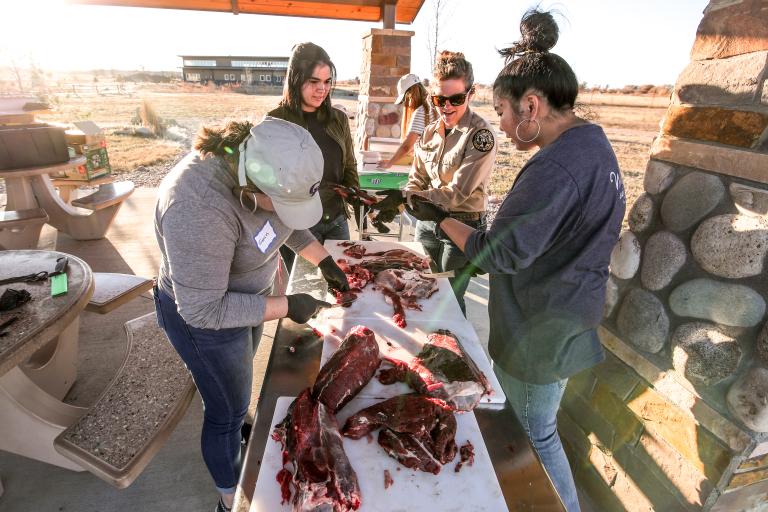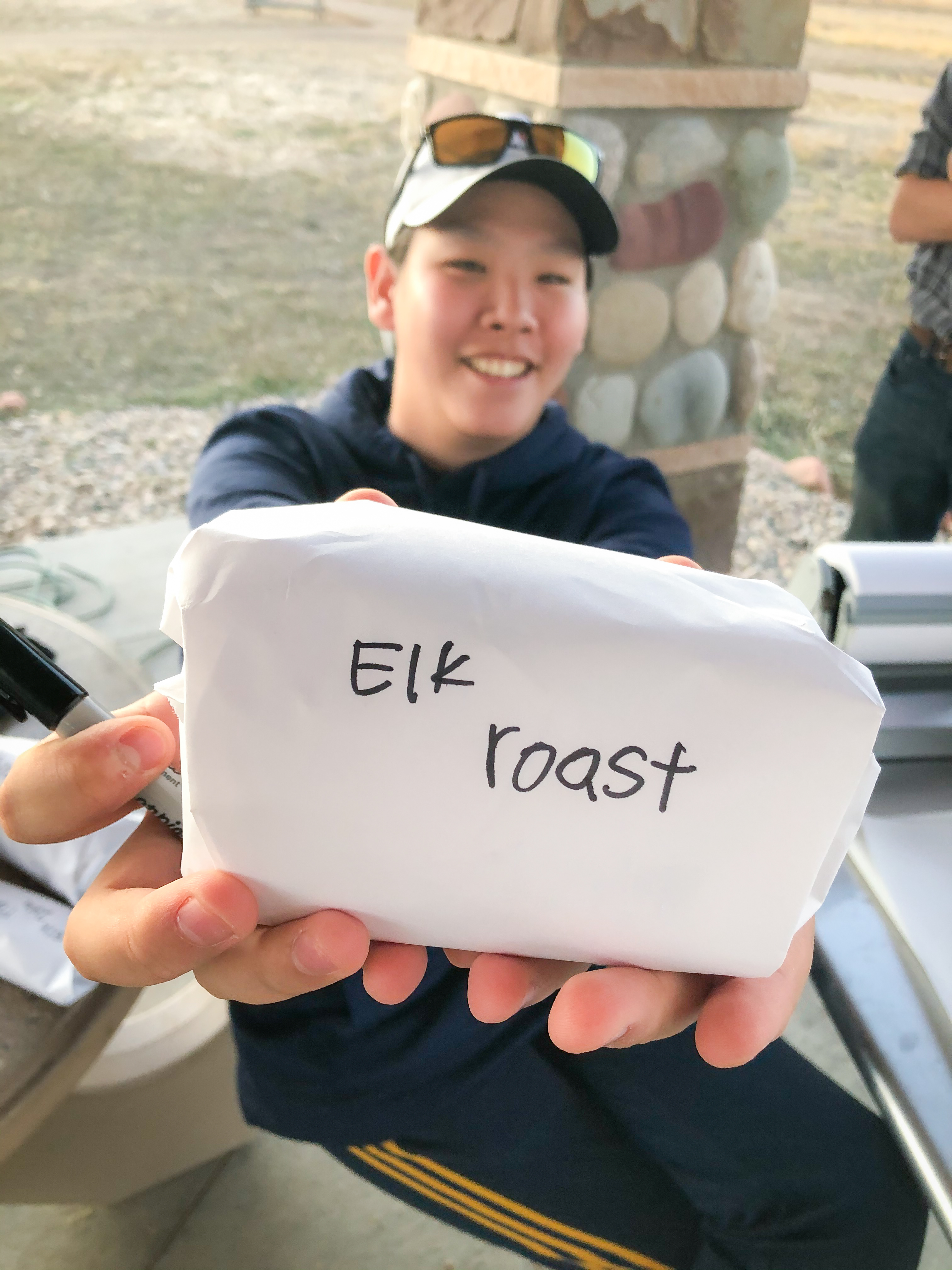Christmas and New Years Office Closure
Colorado Parks and Wildlife offices will be closed on December 24, December 25, December 26 and January 1.
Christmas and New Years Office Closure
Colorado Parks and Wildlife offices will be closed on December 24, December 25, December 26 and January 1.

Health risks due to lead poisoning from consuming game meat are low for most people; however, switching to non-lead ammunition may be an option that’s right for you.
Science tells us that ingesting lead can cause potential human health problems over time. Additionally, lead-based ammunition can cause adverse impacts on non-target wildlife from lead ingestion while scavenging.
Hunters themselves are conservationists, maintaining species populations and protecting habitats. By switching to non-lead ammunition, hunters can support wildlife by reducing the risk of lead poisoning to non-target wildlife such as eagles and other raptors.
To help reduce human and wildlife health impacts, you can:
Hunters can be exposed to diseases when in the field hunting mule deer, white-tailed deer, elk, pronghorn, moose and bighorn sheep.
Abdominal worms live in the abdomen of Colorado deer and more rarely, other species (elk, moose and bighorn sheep). Infections are more common in fawns and yearling deer than in adults. Transmission of worms is through mosquitoes that pick up immature worms while feeding on infected deer and pass the infection to other animals. Worms are frequently seen by deer hunters on the surface of the mesentery in while field dressing animals. The number of worms in the abdomen rarely exceeds about 30, with higher numbers suggesting the deer may have been in poor condition or poor health. The deer abdominal worm does not cause significant disease in deer, with severe cases resulting in only minor irritation in the abdomen.
Deer abdominal worms do not pose a threat to human health and the presence of these worms is considered a normal finding. Hunters are reminded that parasites are a normal finding in all wild game and that proper cooking of meat is always recommended. Although small numbers of abdominal worms are not a concern, in rare cases of severe infections (more than 30 worms, especially in adults) this may indicate an underlying problem with the health of the animal. CPW recommends that any sick animals should not be consumed.
Disease in humans resulting from Chronic Wasting Disease exposure has not been reported to date. However, there may be a small risk from eating meat from infected animals. Although CWD exposure has thus far not been associated with cases of prion disease in humans, public health officials advise against consuming meat or any other tissues from animals known to be infected.
Strong evidence suggests that abnormal proteins, called prions (pree-ons), cause chronic wasting disease in deer and elk. Prions naturally accumulate in certain parts of infected animals -- the brain, eyes, spinal cord, lymph nodes, tonsils, pancreas and spleen - relatively early in the course of disease, well before the animal is visibly ill. However, abnormal prions also can accumulate in a wider variety of tissues and organs, including kidney, lung, heart, and muscle.
Public health officials recommend that people avoid exposure to CWD-infected animals.
Chronic wasting disease belongs to the family of prion diseases, also known as transmissible spongiform encephalopathies.
Within this family of diseases, there are three that affect cloven-hoofed animals:
There also are two main forms of prion disease that affect humans:
For more information about prion diseases, please visit the Colorado Department of Public Health & Environments website.
Deer adenovirus causes death by damaging blood vessels in the lungs, intestines, and/or other organs in deer (mostly fawns), elk, and pronghorn in Colorado. Deer adenovirus is the cause of adenovirus hemorrhagic disease and was first detected in Colorado during the winter of 2015-2016. Like other hemorrhagic diseases, deer adenovirus attacks the blood vessels of affected animals and may cause bleeding into the intestine. Transmission of deer adenovirus is
through direct contact, and outbreaks in Colorado have been associated with congregation of animals both naturally on winter range, and artificially due to illegal feeding practices.
Deer adenovirus is not known to cause disease in species other than deer and other cervids. Cattle and other domestic species do not appear to be susceptible to the disease. Although there is no known human health risk from the virus, hunters are advised not to consume meat from animals that were found dead or seen to be ill or acting abnormally prior to death.
Hemorrhagic disease is a fatal viral disease in white-tailed deer, and a sometimes fatal, but less severe disease in other species (mule deer, elk, bighorn, sheep, pronghorn and bison). Hemorrhagic disease is caused by two closely-related viruses, epizootic hemorrhagic disease virus and bluetongue virus. The disease is transmitted by biting midges, usually in the late summer and early fall. Mule deer bucks that have survived the epizootic infection may have abnormal antlers with retained velvet that are not shed annually, and are covered by bumpy growths.
Neither viruses are transmissible to humans. Both viruses can be transmitted to cattle, but disease is typically mild. Bluetongue virus causes significant disease in domestic sheep, and sheep are usually vaccinated against this virus. Although hemorrhagic disease is not a concern for human health, multiple dead animals can be a sign of other dangerous diseases. If hunters observe multiple sick or dead animals in an area, do not harvest animals from that area, do not handle dead carcasses and report dead animals to CPW.
Avian influenza is deadly to domestic poultry and wild birds. In rare cases, avian influenza can pass to humans if exposed to sick birds.
Colorado Parks and Wildlife asks Hunters to take the following safety steps to reduce the risk of infection.
Protect yourself from avian influenza:
HUNTERS: Monitor your health for any flu-like symptoms within a week after hunting waterfowl and handling birds. If you feel ill, contact your healthcare provider.
Most of the time, properly handled and prepared game meat poses no greater risk than domestic meat of causing or carrying disease that could make humans sick. Hunters are encouraged to contact their local public health department or CPW office for information on wildlife diseases where they plan to hunt. Public health officials recommend the following precautions when handling and preparing game meat:


Donation certificates are required for all donations. Certificates must contain:
The certificate must stay with the meat until the meat is completely consumed. Donor and recipient are subject to all bag and possession limits. A like license is a license for exactly the same species, sex, season and method of take as the donor’s license.
Donate up to 20 pounds
Hunters can donate up to 20 pounds of unprocessed meat, to someone with and without a like license anywhere.
Donate More than 20 pounds
Hunters can donate more than 20 pounds of unprocessed meat, to someone without a like license, only at recipient’s home. Hunters can donate more that 20 punds of unprocessed meat to someone with a like license, anywhere, only if the recipient’s license is unfilled, and the recipient’s carcass tag is on the meat. This establishes recipient’s claim to his/her portion of meat and voids his/her license. Donor’s tag must remain with his/her portion.
Donate an Entire Carcass
Hunters can an entire carcass to someone with a like license if the recipient’s license is unfilled and the donor’s carcass tag and recipient’s like-license carcass tag is on the meat, voiding both licenses.